
Sustainable Eco-Friendly Plumbing Solutions for Modern Homes
Water conservation is a real concern for homeowners in North Dallas who want to protect resources, manage utility costs, and create more efficient homes. In

Water conservation is a real concern for homeowners in North Dallas who want to protect resources, manage utility costs, and create more efficient homes. In
Water conservation is a real concern for homeowners in North
A slab leak is one of those plumbing problems that
Located 20 miles north of downtown Dallas, Plano is Texas’s
When temperatures plummet, your plumbing pipes can freeze and even
*Limit one coupon per household/property. Coupons/discounts cannot be combined with any other offers. Restrictions may apply.
Legacy Plumbing HQ
1101 E Eldorado Pkwy
Little Elm, TX 75068
469-389-4020
Legacy Plumbing Frisco
15222 King Road, STE 1002
Frisco, TX 75034
972-752-6537
8:00 AM to 5:30 PM
Monday – Friday
Legacy Plumbing HQ
1101 E Eldorado Pkwy
Little Elm, TX 75068
(972) 801-9798
Legacy Plumbing Frisco
8765 Stockard Dr # 104,
Frisco, TX 75034
(972) 801-9798
7:00 AM to 5:30 PM
Monday – Friday
If you are experiencing repeated issues with toilets backing up or drains getting clogged there is usually some underlying cause that should be resolved.
Sewer systems are designed to be maintenance-free aside from perhaps a few things like occasional grease buildup on a kitchen drain line or hair clogging a P-trap.
In this article, we will focus on some of the problems that the typical North Texas home might experience and what the best solutions are: whether it is a comprehensive cleaning of the sewer line, the repair of a broken fitting, or the replacement of an entire section of the system.
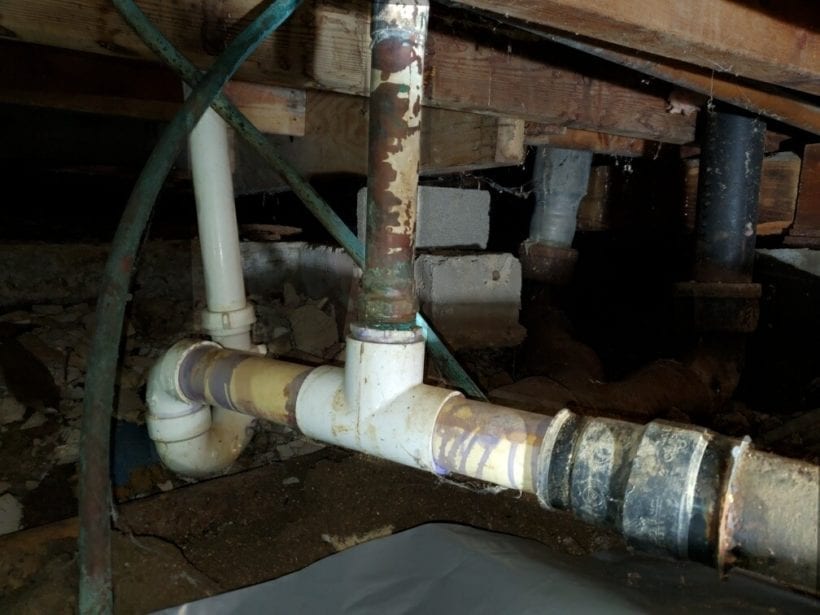
Cast iron piping was the standard material used for water and sewer lines in homes built before the mid-1980s. In the mid-1980s, PVC plastic piping became widely available in the residential construction industry. It was at this time that cast iron became virtually extinct for use in home plumbing systems. PVC was lighter, easier to install, and would not corrode like cast iron.
Before the 1960s, it was also common to use clay or terra cotta for the drain lines that ran from the house to the main city waste pipes.
There was a period directly after WWII during which Orangeburg piping was installed. This nonmetallic piping is made from bituminized fiber and was commonly turned to for residential use due to supply chain issues caused by the war. This piping can be found in houses built from the mid-1940s up into the 1960s.
In our service area across the North DFW area, there is a pretty good mix of both cast iron and PVC piping systems. The cities that are directly north of Dallas (like Richardson, Carrollton, Plano, and Lewisville, and The Colony) have large swaths of houses built quickly in the 1970s and early 1980s by large home builders like Fox and Jacobs. In these homes, you’ll find cast iron drain lines below the slab foundations and out in the yard. Toward the end of this period, the builders started to transition to PVC only above the slab with cast iron still below.
Cities located further north (like Frisco, Mckinney, Prosper, and Allen) contain mostly houses built from 1990 to the present. All of these houses use PVC for the drain systems.
In the early days of sewer and water lines, the different sections of piping were connected with lead and oakum. This labor-intensive process involved packing the gaps in the hub joints with a fibrous material called oakum and then pouring molten lead into the gap to create a water-tight seal.
Later toward the end of cast iron piping’s reign, this method was replaced with using rubber, donut-shaped gaskets called “donuts” or “compression gaskets” to join the pipes in the same way. They also started using PVC rubber couplings that joined to the pipes with stainless steel clamps.
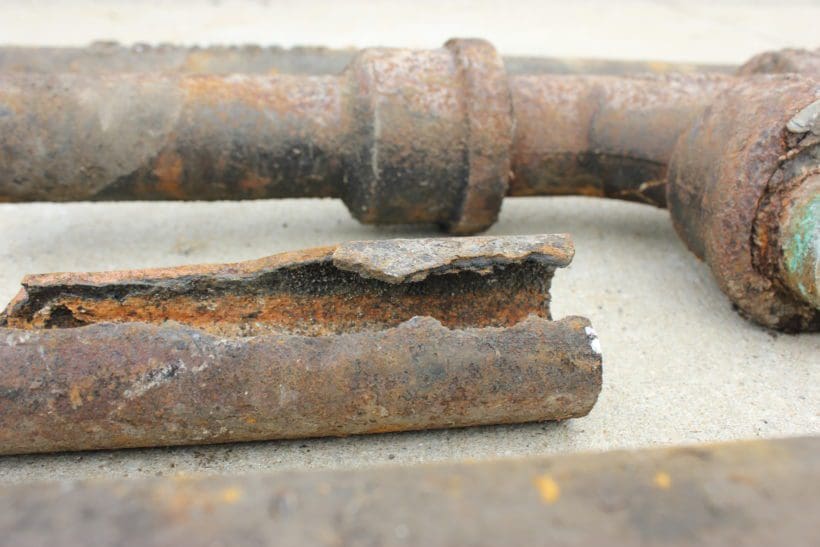
Cast iron is very heavy and not flexible at all, but there is some inherent flexibility at each of the connecting points due to the way the pieces are joined. This means that it is uncommon to see cast iron drain piping crushed or damaged by force or soil movement.
However, extensive soil movement does have the ability to compromise the seal at the joints. When this happens, water begins to leak out every time water flows down the drain. Over time, the moisture and added nutrients in the soil surrounding the leak attract tree roots which then start to grow into the pipe at that point.
It is only a matter of time before this ends up clogging the pipe. The roots can usually be cleaned out with a sewer machine if there isn’t a significant break, but they will almost always grow back – making this a perpetual maintenance situation until the piping is replaced.
If the pipe wasn’t bedded in properly during installation or if there was a significant amount of ground shifting, cast iron can flex at the joints and allow for the creation of bellies or dips in the horizontal sewer line where water doesn’t flow smoothly.
These bellies will usually don’t result in a stoppage right away, but they will often collect buildup over time – resulting in more frequent clogs. The significance and frequency of these clogs depend a lot on the age of the system, how the system is used and how bad the belly is.
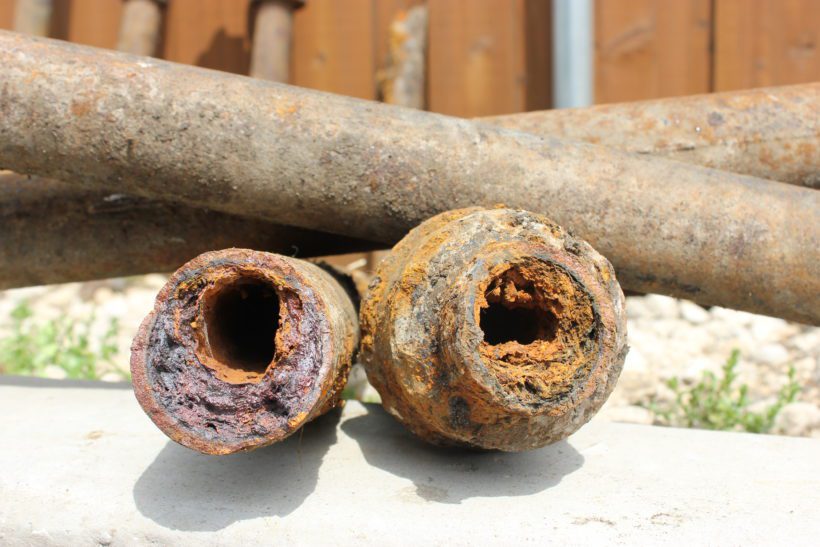
The main issue with cast iron piping is the way it deteriorates over time. It is only a matter of time before all horizontal cast iron piping rusts out to the point of failure. In our experience, the older cast iron piping seems to have been manufactured a bit more robustly than the cast iron piping created toward the late 1970s and early 1980s before it was phased out.
Regardless of when it was created, though, the pipe will rust from both the inside and the outside. The majority of the deterioration occurs from the inside out, though. The natural oxidation precipitated by water is often accelerated by detergents and other strong cleaning products put down the drain.
Older cast iron sewer systems tend to clog up more frequently due to the roughness inside the pipes. Long before the cast iron has fully deteriorated to the point of leaking, the beginning of this process creates rough surfaces inside that allow particulates and grease more surface area to build on.
This is exacerbated by the modern water-saving fixtures that are installed in people’s homes during remodels or upgrades. “Low-flow” toilets that flush 1.28 gallons each time they are used are particularly notorious for this. They can flush very well and clear the bowl of waste, but there simply isn’t enough water to carry the waste out of the rough, cast iron piping to the municipal waste system.
We see these types of issues quite a bit in transitional neighborhoods in North Dallas, Richardson, Plano, and the like where homes are being purchased and extensively updated/remodeled. It is for this reason that we almost always recommend rebuilding the toilets in old houses with cast iron plumbing rather than replacing these with new, low-flow toilets.
If the cast iron pipe hasn’t broken or deteriorated significantly, the rough internal surface can be cleaned out for better drainage. If there is a clog on the system, this will generally be cleared first by a drain snake machine.
After the flow is restored, a jetting machine or a chain knocker will be used to scrape the sides of the pipe and smooth out all that rust and particle buildup. Once all of this breaks up, it will be washed down the drain.
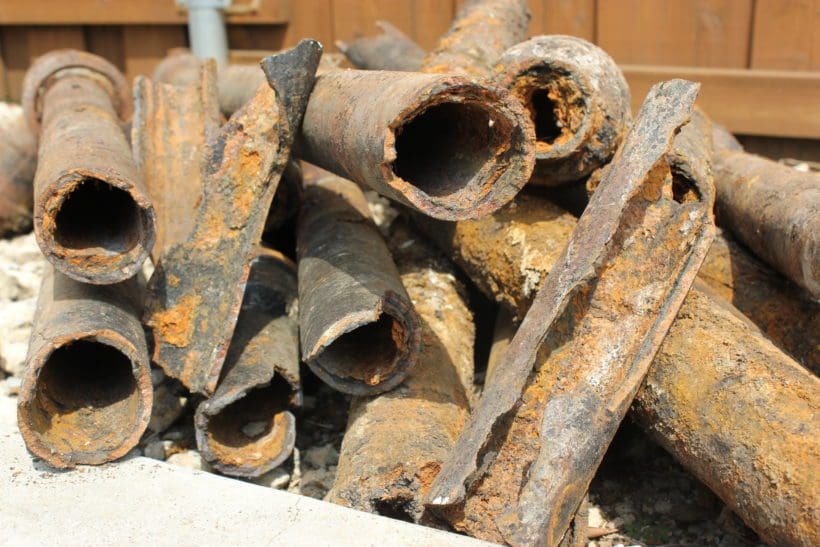
All of the issues that cast iron pipes experience simply get worse with age. When we come out to a house to address extensive issues with cast iron sewer piping, it is often decided to replace entire sections of the system instead of a single spot where the blockage happens to be right at that time. Due to the age and state of deterioration, this is usually a much better long-term fix instead of just a Band-Aid repair.
Whether it is a small section of repiping that is being replaced or whether it is all of the pipes under the slab, the cast iron pipe is typically adapted to the new PVC with rubberized, reinforced PVC couplings made for this purpose. Sometimes the new pipes preserve the same layout as the original design. Other times, the sewer lines are rerouted to facilitate the repair process. Learn more about our sewer line repair/replacement on our service page.
PVC stands for Polyvinyl Chloride. It is one of the world’s most-manufactured polymer plastics. It is used in everything from clothes to construction materials.
Straight, inflexible sections of PVC piping are joined with PVC fittings of various kinds. The joining method is known as solvent welding – a liquid chemical solvent is used to temporarily soften the surfaces of the outside of the pipe and the inside of the fitting. The surfaces are pressed together and soon fuse. When done properly, this creates a very reliable and water-tight bond. Most people refer to this process as gluing PVC.
PVC material has many advantages over cast iron – it is cheaper to manufacture, there is less cost for transportation, there is labor in installation, it doesn’t rust or deteriorate like cast iron, and it has a smoother internal surface.
All of these advantages easily outweigh the few disadvantages for residential construction – which is why it did not take long for the house construction industry to completely switch over. The lower expenses of this material greatly contributed to the modern trend of large, spread-out bathrooms and the flexibility of putting bathrooms anywhere in the floorplan of the house.
However, PVC systems are not bulletproof. PVC tends to allow more noise transfer, has more flammability potential, and is less resistant to force damage. Some of the issues cast iron systems experience still apply to PVC. There are a few additional weaknesses that PVC brings to the table such as susceptibility to cracked fittings and a higher risk of accidental damage.
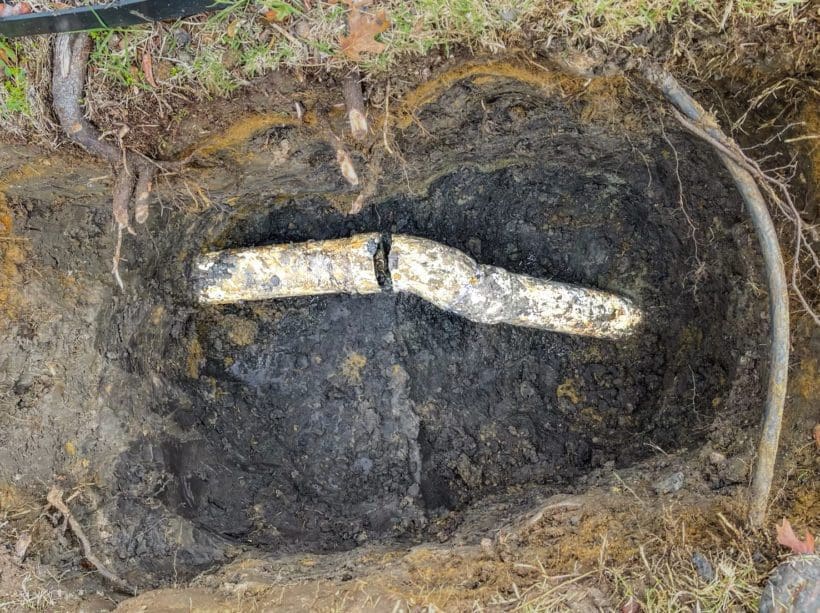
When PVC isn’t joined properly or if the connections are put under excessive force, they can sometimes pull apart, but this isn’t very common. The straight sections of PVC have some flexibility and tend to “give” rather than break. The weak points are generally the fittings.
It is much more common for the PVC fittings to crack when they are subjected to heavy pressure – such as is caused by ground movement over time. Once this happens, it is again only a matter of time before roots find their way into the line and create clogs just like in cast iron piping.
PVC is also much more likely to get accidentally damaged than cast iron. When it is installed, plumbing code dictates certain protective measures – like the installation of nail plates. But it isn’t uncommon for these pipes to be damaged anyway during construction or afterward when screwing or drilling into a wall.
Because of the “bending” ability that long straight sections of PVC have, the possibility of “bellies” is also very high if the pipe isn’t “bedded in” properly during construction or if the house has experienced foundation movement. When this happens, usually the entire section of the pipe will have to be replaced to correct the shallow grade.

Fortunately for most issues that PVC experiences (such as accidental damage or a cracked fitting) only the single damaged spot needs to be repaired. This is because PVC doesn’t have a “shelf life” as cast iron does. It doesn’t corrode from the inside out; household chemicals won’t eat away at it. Usually, repiping of PVC is only necessary is when there has been a large amount of slab foundation damage.
PVC is a bell and spigot type of piping, which sometimes does complicate the repair process if there are fixed ends that cannot be easily slid back and forth. Typically, the broken fitting or section of pipe is cut out entirely and replaced with the same pipe/fitting arrangement. Slip-type rubberized PVC couplings are then used where necessary to tie this assembly back in.
If you have having repeated issues with a single fixture backing up, this might be an issue of hair or buildup in that particular fixture’s drain assembly or the fixture P-trap. This can often be manually cleaned out with an inexpensive drain tool or by disassembling the slip joint connections of sinks and cleaning them manually.
If multiple fixtures are backing up or if you are having repeated issues, the pipe may need to be cleaned with professional sewer cleaning equipment. It is also possible there may be roots or a break in the line somewhere.
At Legacy Plumbing, every single truck carries both drain machines and camera inspection/locating equipment. That means we not only can get the drains flowing again but we can properly diagnose the system and discuss whatever options are available for permanently fixing the underlying problem.
To find out pricing and schedule availability, give us a call today at (972) 632-5412
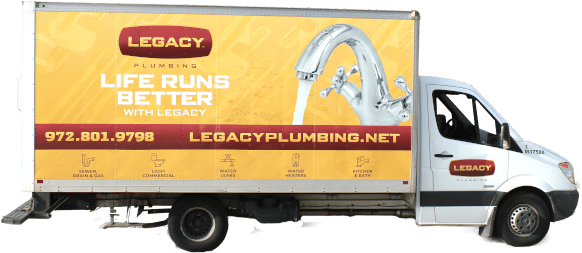
If you found this helpful, please take a minute to share it on social media. Also, feel free to pass this content along to friends/family/clients of yours who may find this helpful.
Headquarters
1101 E Eldorado Pkwy
Little Elm, TX 75068
Legacy Plumbing Frisco
8765 Stockard Dr # 104, Frisco, TX 75034
7:00 AM to 5:30 PM
Monday – Sunday